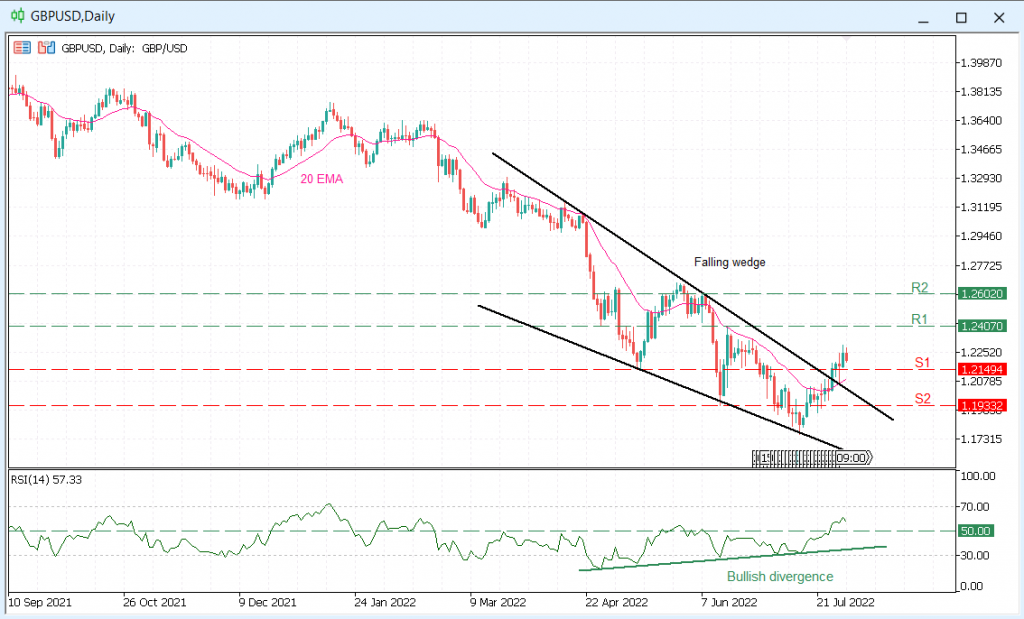
After slipping into a downtrend since June 2021, the GBPUSD rebounded in mid-July 2022 and it had since broken out of a falling wedge, which is a tell-tale sign for a potential larger leg up. The rebound across most major pairs could be largely attributed to the weakening greenback which saw the US Dollar Index (DXY) retracing steeply from its 20-year high at 109.3 to hover around 105.
Weakening USD as US enters technical recession
Last week, the US Bureau of Economic Analysis revealed that the US economy shrunk by 0.9% in Q2. The Gross Domestic Product Annualized data, is a gross measure of market activity because it indicates the pace at which a country’s economy is growing or decreasing. A negative reading is typically bearish for a nation’s currency.
Moreover, this also marked the second consecutive quarter that the US experiences a negative GDP growth, which suggests that the US economy is in a technical recession. While the US Federal Reserve insists that the US economy is not in a recession by citing the strong labour market in June, markets are increasingly pricing in a more dovish Fed going forward as recession fears grow. The expectations of a less hawkish Fed monetary policy drives the US Dollar weaker against the rival currencies.
Up next, markets will be paying close attention to this Friday’s Nonfarm Payroll data where 250K new jobs are expected to have been added in the US economy in July. Any figure lower than the market consensus would send the USD even lower as a recession becomes more apparent.
Technical Analysis
GBPUSD on the daily chart had broken out of a falling wedge that stretched back to April. A falling wedge, identified by two converging downward sloping trend lines, is a bullish reversal pattern that means prices would tend to bounce higher upon completion of the formation. The breakout was also in line with a bullish divergence on the Relative Strength Index (RSI). At the time of analysis on 2 August 2022, the pair is showing bullish momentum as the RSI crossed above 60 for the first time since January. The Moving Average Convergence Divergence (MACD) histogram on the other hand, had also pierced above zero after staying in the negative territory for five months.
Looking ahead, we anticipate the GBPUSD to retrace and establish support above 1.2149 (S1). If price finds support above this level, the pair would resume its uptrend to test next resistance at 1.2407 (R1).
Key events to watch this week:
Tuesday, August 2
USD – Fed’s Evans speech
Wednesday, August 3
USD – Fed’s Bullard speech, S&P Global Composite PMI(Jul), S&P Global Services PMI(Jul), Factory Orders (MoM)(Jun), ISM Services Employment Index(Jul), ISM Services New Orders Index(Jul), ISM Services PMI(Jul), ISM Services Prices Paid(Jul).
GBP – S&P Global/CIPS Composite PMI(Jul)
TThursday, August 4
GBP – Bank of England Minutes, Bank of England Monetary Policy Report, BoE Asset Purchase Facility, BoE Interest Rate Decision, Monetary Policy Summary, BoE’s Pill speech, BoE’s Governor Bailey speech
USD – Goods and Services Trade Balance(Jun), Initial Jobless Claims(Jul 29), Initial Jobless Claims 4-week average(Jul 29)
Friday, August 5
EUSD – Fed’s Mester speech, Average Hourly Earnings (MoM)(YoY)(Jul), Labor Force Participation Rate(Jul), Nonfarm Payrolls(Jul), U6 Underemployment Rate(Jul), Unemployment Rate(Jul).
Trade Forex on Phillip MetaTrader 5 (MT5).
Trade Forex at zero commission on Phillip MetaTrader 5, a dynamic platform that offers low spreads. Integrated with Acuity’s Signal Centre and Trading Central Indicators, and available on mobile and desktop app, you will never miss a trading opportunity with Phillip MT5.
Download Trading Central’s Market Buzz for updates on more topics.
What’s more? Phillip MT5 is now supported on Mac OS! To install, simply download the file below and complete a simple installation process.






